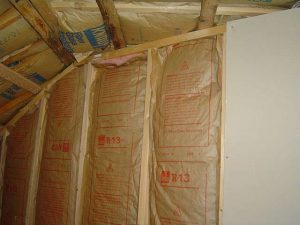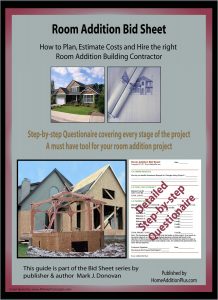Keep Your Garage Warmer by Insulating Garage Walls and Ceilings
By Mark J. Donovan
|
|
A few years back I decided to sheetrock my garage. Before I hung the sheetrock, however, I installed insulation in the garage walls and ceiling. Though I could probably have skipped the time and expense of insulating the garage, I thought that someday I may also want to heat the garage. In addition, insulating garage walls and ceilings is relatively simple to do and the costs are not outlandish.
I chose to install R-19 rolled faced fiberglass insulation since my garage was framed with 2×6 walls. I also used R-38 faced insulation in the garage ceilings. |
Due to the fact that fiberglass insulation is extremely irritating to the eyes, throat and skin I wore full length pants and a long sleeve shirt, even though it was about 75o degrees in the garage. I also wore goggles and a mask to protect my eyes and throat.
To insulate the garage walls I first measured the wall height and counted the number of bays between walls studs. With this information I was able to calculate the number of linear feet of insulation required and purchase the necessary rolls of insulation. I did the same for the garage ceilings.
| To install the garage wall insulation, I simply cut lengths of insulation on the floor of the garage, equal to the wall height. I used a utility knife and a length of 2×4 to cut the insulation. Cutting faced insulation works best if you cut it from the faced side while pressing it down with the 2×4.
Next I installed the lengths of insulation into the wall stud bays, making sure that I didn’t leave any gaps. I also made sure to have the paper side face inwards, toward the inside of the garage. I then stapled the paper faced tabs to the wall studs. |
 |
After insulating the wall stud bays I then filled in the small crevasses with either strips of fiberglass insulation or with foam insulation that comes in a can. The foam insulation works great for very narrow spaces around doors and windows. For a quality insulation job it is important to insulate all gaps in the walls, so don’t skip insulating these crevasses.
Once I completed insulating the garage walls I then moved on to the ceiling. First, however, I nailed up 1”x3” strapping to the roof joists. I ran them perpendicular to the roof joists and placed them on 32” centers, and used two nails per roof joist to secure the strapping.
Living in New Hampshire I typically observe the garage to be about 30o warmer than the outside air temperature during frigid cold nights. I observe this by noting the outside air temperature from my car thermometer when I first get into the car, and then watching the temperature drop as I leave the garage and drive to work. Living in New Hampshire I typically observe the garage to be about 30o warmer than the outside air temperature during frigid cold nights. I observe this by noting the outside air temperature from my car thermometer when I first get into the car, and then watching the temperature drop as I leave the garage and drive to work.
For help on building a home addition, see HomeAdditionPlus.com’s Home Addition Bid Sheets. Our Home Addition Bid Sheets provide you with the knowledge and information on how to plan a home addition project, and what to look for when hiring contractors. They also include detailed cost breakdown tables and spreadsheets for estimating your own new home addition building costs.
Related Information
Free Home Addition Price Quotes with No Obligation!
Fill out our 3-5 minute quick and easy form, and receive a free price quote on a house addition from one of our prescreened and licensed home addition contractors. This process is free and there is no obligation to continue once you receive your house addition price estimate.

